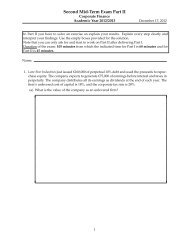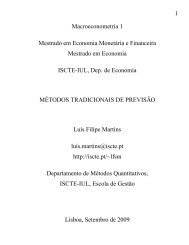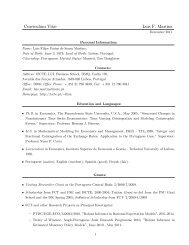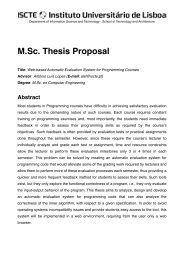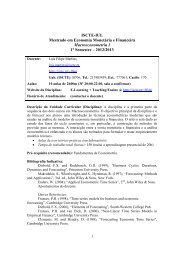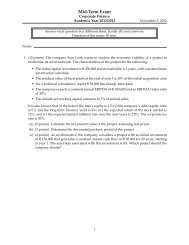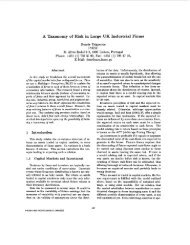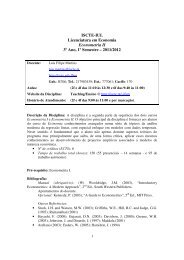The Information Content of Accounting Numbers as Earnings ...
The Information Content of Accounting Numbers as Earnings ...
The Information Content of Accounting Numbers as Earnings ...
You also want an ePaper? Increase the reach of your titles
YUMPU automatically turns print PDFs into web optimized ePapers that Google loves.
hypothesis that the estimated process is no different from a random walk at the 0.05 level”. Albrecht,<br />
Lookabill & McKeown (1977) reported a similar result. Departures from random walk are<br />
reported only when researchers adopt sample stratification analysis. Brooks and Buckm<strong>as</strong>ter<br />
(1976; 1980) examined a sample <strong>of</strong> US Compustat firms, stratifying their sample by the magnitude<br />
<strong>of</strong> the previous year’s earnings change. <strong>The</strong>y concluded that “a large relative incre<strong>as</strong>e in income is<br />
generally followed by two or more periods when the firm underperforms the average or most likely<br />
outcome. Likewise, a firm with a large relative decre<strong>as</strong>e in income generally outperforms the average<br />
or most likely outcome for two or more periods following the large incre<strong>as</strong>e”. This result<br />
h<strong>as</strong> been reported in other studies, for example, Beaver, Lambert & Morse (1980) and Freeman,<br />
Ohlson & Penman (1982).<br />
Instead <strong>of</strong> pursuing the path adopted by most researchers, Ou and Penman (1989) and Ou (1990)<br />
used non-earnings accounting numbers to predict earnings changes one year ahead. <strong>The</strong>ir results<br />
provide evidence for both a “predictive information link” between some non-earnings annual report<br />
numbers and future earnings changes and a “valuation link” between predicted future earnings<br />
changes and stock returns during the annual report dissemination period. 3 <strong>The</strong> predictive information<br />
link stems from fitting binary one-year-ahead earnings prediction models to selected annual<br />
report data and comparing these models’ prediction power with that <strong>of</strong> a random walk.<br />
Ou’s (1990) results also provide an additional explanation for a result reported in Ball and Brown<br />
(1968). <strong>The</strong>se authors noticed that the information on reported earnings is anticipated by the market<br />
<strong>as</strong> early <strong>as</strong> 12 months prior to the preliminary earnings announcement. <strong>The</strong>y speculate that<br />
other news events, such <strong>as</strong> dividend and interim earnings announcements, might explain why “unexpected<br />
earnings” are anticipated. <strong>The</strong> predictive information link documented in Ou’s (1990)<br />
study suggests that the rele<strong>as</strong>e <strong>of</strong> the previous year’s complete annual report, an event included in<br />
Ball and Brown’s (1968) abnormal return accumulation period, provides useful information for<br />
forming expectations about the current year’s earnings.<br />
Ou (1990) used a dichotomous variable to predict the sign <strong>of</strong> the change in one-year-ahead earnings,<br />
i.e., an earnings incre<strong>as</strong>e or an earnings decre<strong>as</strong>e. A change in firm i’s earnings in year t+1,<br />
denoted EPSit+1 is calculated <strong>as</strong>:<br />
EPSit+1 = (EPSit+1 - EPSit) - driftit<br />
where EPSit+1 and EPSit are firm i’s “<strong>as</strong> reported” earnings per share before extraordinary items<br />
for years t+1 and t, respectively. <strong>The</strong> drift term for year t is defined <strong>as</strong> the mean earnings per share<br />
change over the four years prior to year t and is required for eliminating any apparent trend in<br />
earnings. EPSit+1 is thus an unexpected change. After fitting univariate logit models for 61 financial<br />
ratios potentially useful <strong>as</strong> predictor candidates, only 8 such descriptors, with an estimated<br />
coefficient significant at the 10% level, were retained. <strong>The</strong>n multivariate logit models were used<br />
for these descriptors to find appropriate models. <strong>The</strong>se descriptors are:<br />
(1) % INVTA: percentage change in the “inventory to total <strong>as</strong>sets” ratio;<br />
(2) % SALTA: percentage growth in the “net sales to total <strong>as</strong>sets” ratio;<br />
(3) % DPS: change in “dividends per share”, relative to that <strong>of</strong> the previous year;<br />
(4) % DEP: percentage growth in “depreciation expense”;<br />
(5) % CPXTA1: percentage growth in the “capital expenditure to total <strong>as</strong>sets” ratio;<br />
(6) % CPXTA2: % CPXTA1, with a one-year lag;<br />
3 In this framework, the observed contemporaneous <strong>as</strong>sociation between accounting data and stock prices is<br />
the result <strong>of</strong> an “information link” between accounting data and future streams <strong>of</strong> benefits from equity investments<br />
and a “valuation link” between future benefits and stock prices. <strong>Information</strong> disclosure triggers<br />
revisions <strong>of</strong> investors’ expectation <strong>of</strong> the future benefits. <strong>The</strong>se revisions are then reflected in current stock<br />
prices. This framework is formally presented in Ohlson (1979) and Garman and Ohlson (1980), and empirically<br />
tested by E<strong>as</strong>ton (1985).<br />
2






